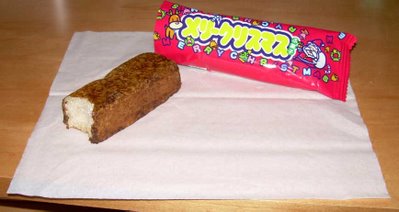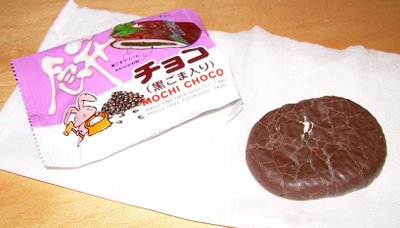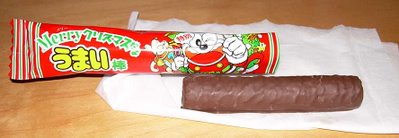 A Christmas goods display at Queen's Isetan market. It includes Christmas boots full of snacks for kids, marshmallows, fondue kits, imported plastic canes full of candy kisses and cookies.
A Christmas goods display at Queen's Isetan market. It includes Christmas boots full of snacks for kids, marshmallows, fondue kits, imported plastic canes full of candy kisses and cookies.
If you're a kid in Japan, you're not likely to be getting very worked up about Christmas. You're far more likely to get excited about the new year's holidays when you get a prolonged vacation from school and can look forward to gift money from all of the relatives. While kids generally get a little something for Christmas, it's nothing like the rain of gifts kids may get in the U.S. or other largely Christian countries.

I have asked students what they were given as children and they have mentioned the style of "stocking" or boot that you see above which is sold for 1050 yen ($11.78). These boots are full of regular snacks like
Baby Star Ramen, (plain) popped popcorn, and "bo" (stick) snacks.
Yaokin sticks are particularly common.

There are also some big bags of powdered drink mixes and cookies which are offered with Christmas-themed wrapping, but they're also nothing special. The cookies pictured above with a Santa lion motif are just plain and chocolate animal crackers that are around all year being re-purposed.
I have actually purchased and detailed the contents of such Christmas packs before, but not in this blog. I did them several years ago in my former personal blog. I've seen exactly the same packs show up year after year at the local 99 yen shop, so I'm not going to buy a new one and review it again. I will, however, paste the review of one of those packs here for you to read. This was from December 2006, but it is just as valid today:
 Santa is almost perversely overjoyed.
Santa is almost perversely overjoyed.One thing my husband and I used to do when we first arrived in Japan was buy some random packaged item and find out what was inside. We stopped doing that a long time ago. I rather forgot why. It struck me that it might be interesting to give that a try again. After sampling the contents of the happy package above, I believe the reason we stopped is for the same reason that you touch a hot stove once and then never do it again. Curiosity may not kill the cat but it can sure turn off his taste buds and offer up a belly-ache.
The Christmas Pack pictured above is meant for children and only cost 99 yen at a convenience store. I didn't have great expectations of gourmet contents and I thought that it may be more interesting because it would show what sort of items are supposed to appeal to children. Unsurprisingly, the items in the bag are the kind of things you see in the candy and snack aisles which are geared toward kids in markets.

This bar resembles a cake when you see a smallish picture of it but if you click and see a larger picture, you can see it is far from a cake. It is called "Merry Christmas wheat gluten (fu) snack". I'm sure many children this year will be writing Santa and asking for special treats made of wheat gluten. The package, as best I can read, seems to be saying that it is a nutritionally-balanced snack. Among the main ingredients are brown sugar, sugar, glutinous flour, and all-purpose flour. It smells like a mixture of burnt sugar and bouillon cubes. The description says something about minerals being in it. The outside is incredibly sweet and the inside is a tasteless quasi-puffed corn snack texture. It was perfectly vile when I forced myself to taste it.

This is a "black sesame
mochi choco". I tried to pull this apart so you could see the center but it was too tough to separate. The chocolate just broke up. I did take a small bite of this and it out-did the wheat gluten bar in disgustingness. It was absolutely horrible. I'd try to describe it but I'm trying to allow the brain cells that retain that information to atrophy and die. Among the ingredients for this one are "chocolate" (no ingredients for the chocolate are given), corn syrup, sugar, cornstarch, sesame seed paste, mochi (like rice "taffy", though it's usually called rice "cake"), powdered milk, and soy beans. I liked how the package actually used correct English but confused "they're" and "their" (click the picture to see a larger one to clearly see the slogan). Of course, American young people who have grown up on the internet probably couldn't tell the difference between the two anyway.

This is "morokoshi wa
taro" or, essentially, "corn and
corm rings". Among the ingredients are corn, taro (a Japanese corm), vegetable oil, and spices. They don't smell like much of anything and taste like an airier, relatively flavorless Chee-to. I'd call these rather inoffensive to mildly pleasant because of the texture.

This one is called "Umaka Christmas" which as best I can work out means "sweet Christmas". My research indicated that "umaka" is another way of saying "umai" in a particular dialect but this may be an incorrect translation. Among the ingredients are corn grits, vegetable oil, sugar, pork extract, salt, onion powder, chicken consomme, Japanese rice (uruchi rice) and fructose. This was the only item in the package which I thought was relatively pleasant tasting. The onion powder and consomme were noticeable and the texture was fine.

This is "Merry Christmas Umai (Sweet) stick". This actually wasn't bad. The chocolate on the outside tasted okay and the inside was a hollow log which tasted like and had a similar texture to Kix cereal only it was puffier and airier. Among the ingredients are sugar, vegetable oil, corn, powdered milk, chocolate mousse, cocoa, flour, non-fat powdered milk, soybean milk and flavoring.
If nothing else, this exercise pushed my husband and I to do some translating. It also explains why Japan
imports so much corn. I think a good portion of it must be processed into these sorts of snacks.
To me, this was a classic example of something you see a fair amount of in Japan. That is, it's something which looks far better on the outside than it actually is on the inside. Maybe kids go nuts for this stuff but I bought this bag over a week ago and the QQ branch I bought it from looked to have just as many in stock as when I purchased mine.



















































